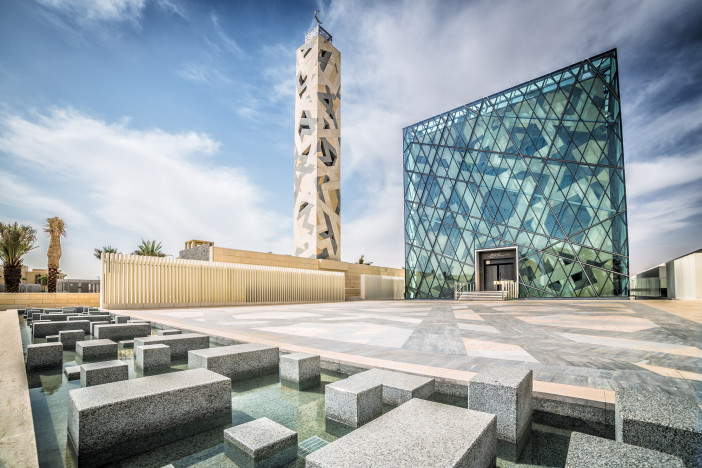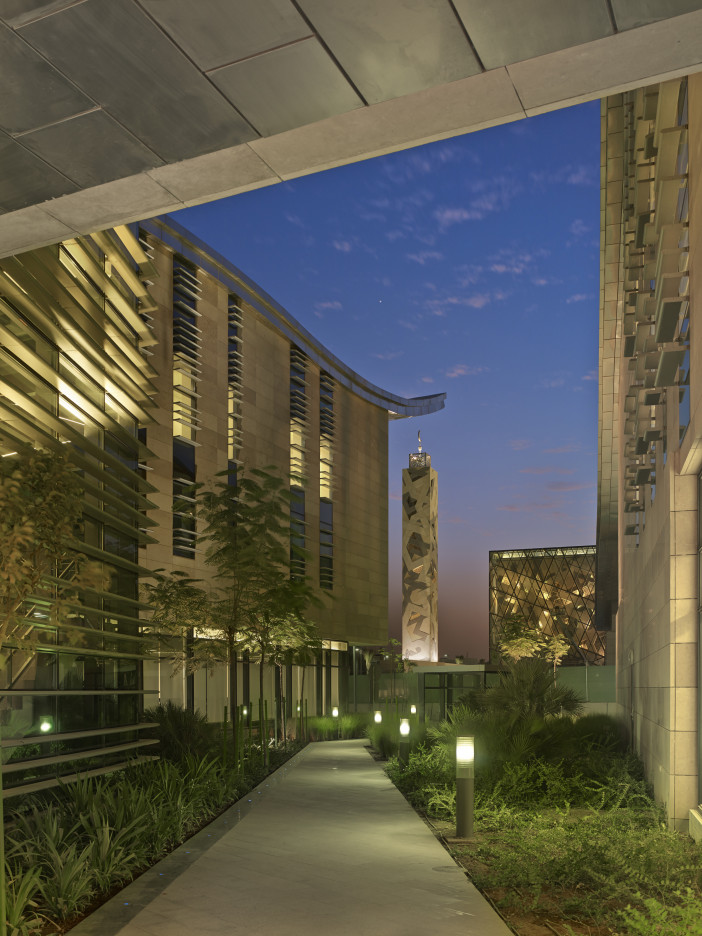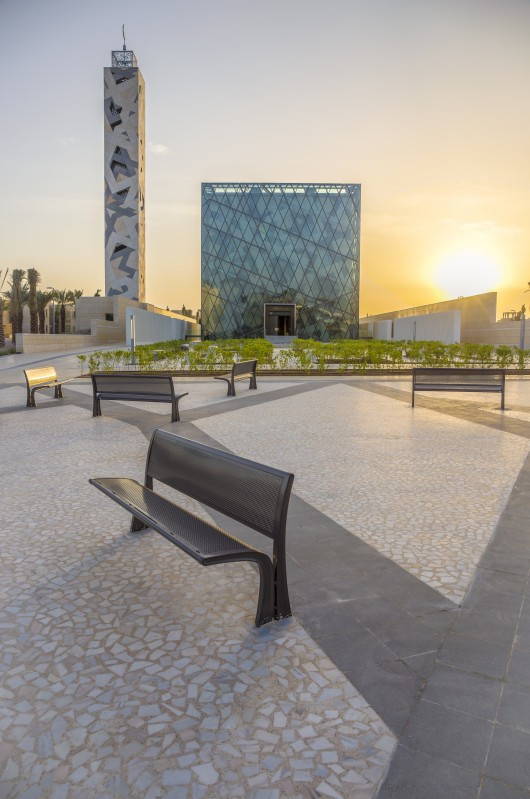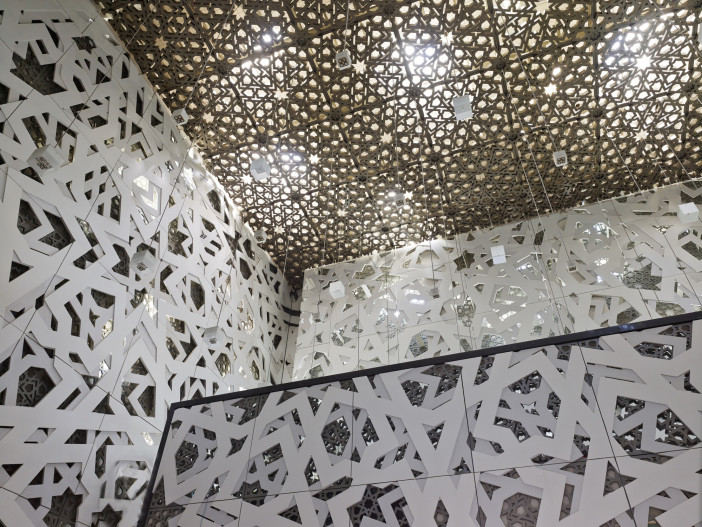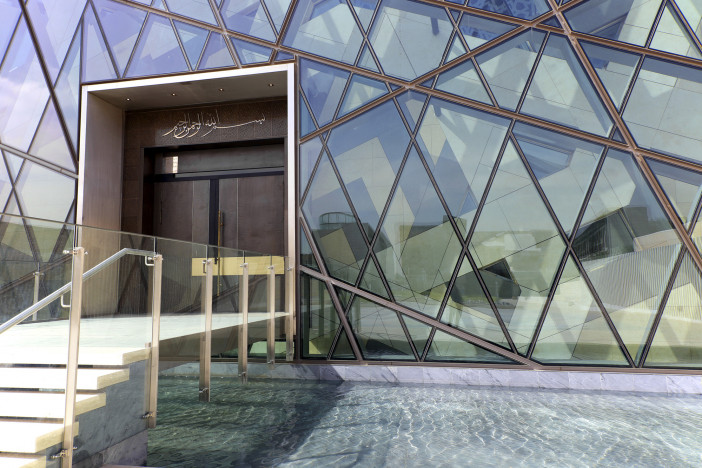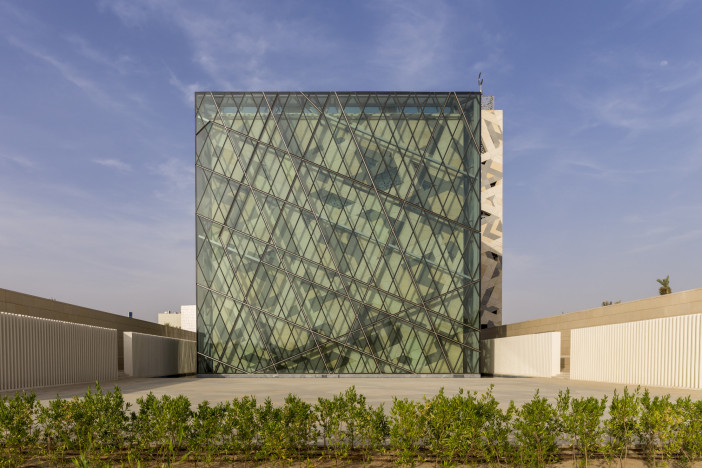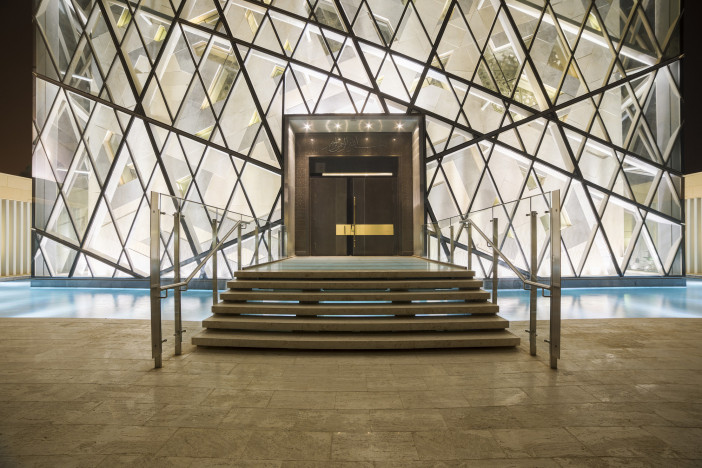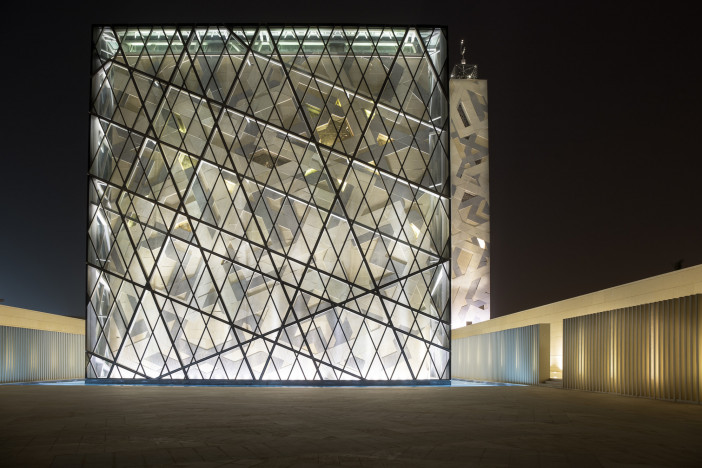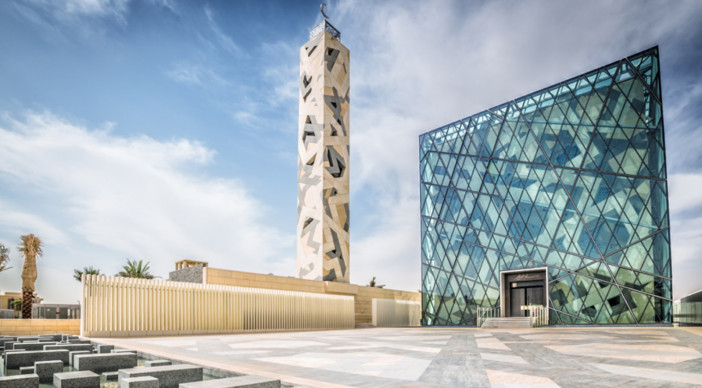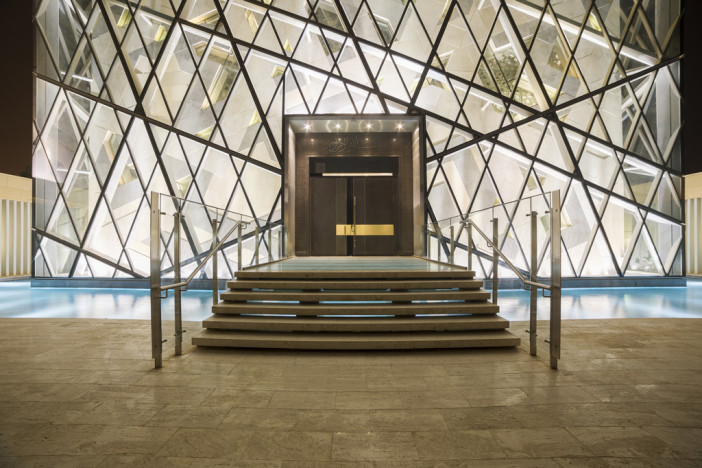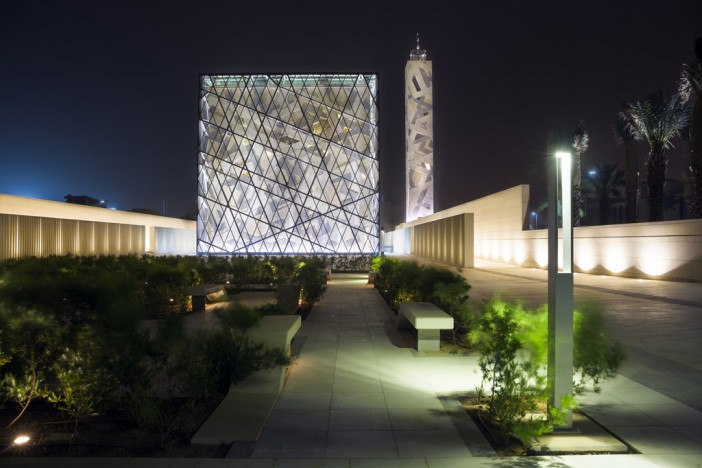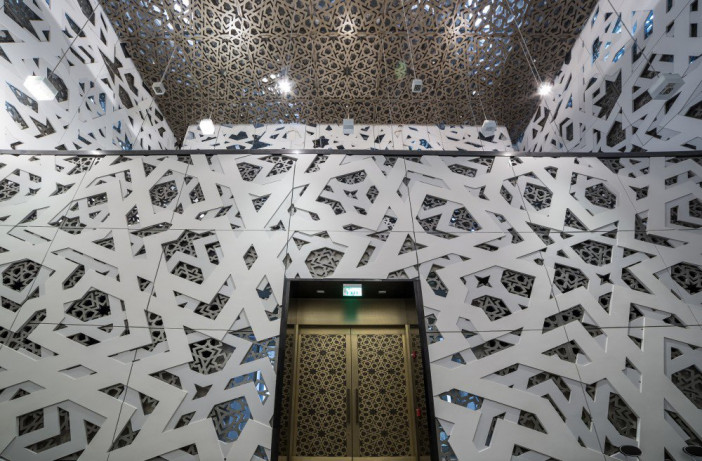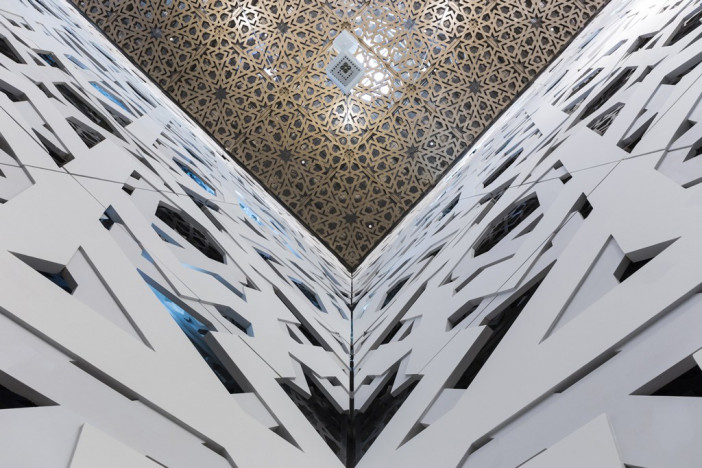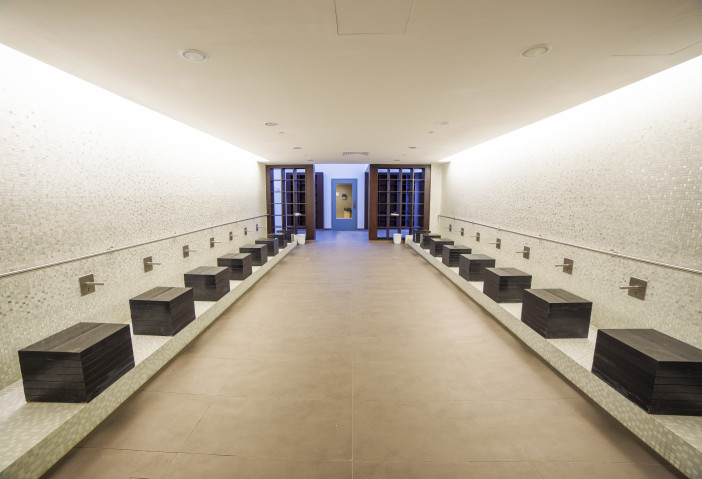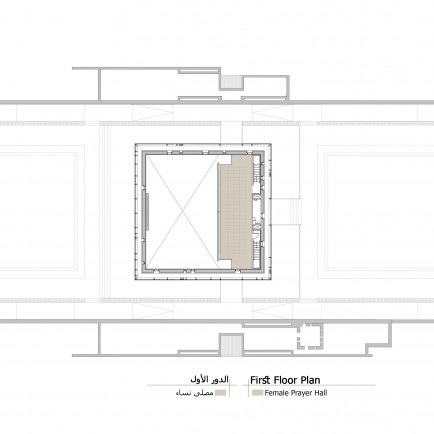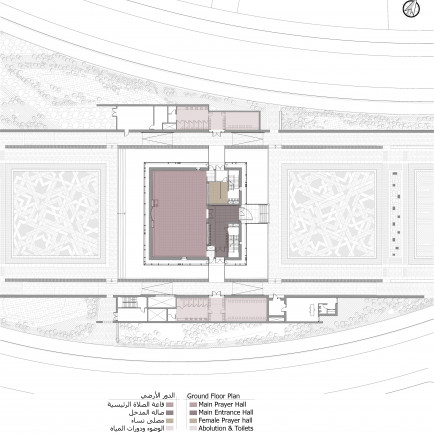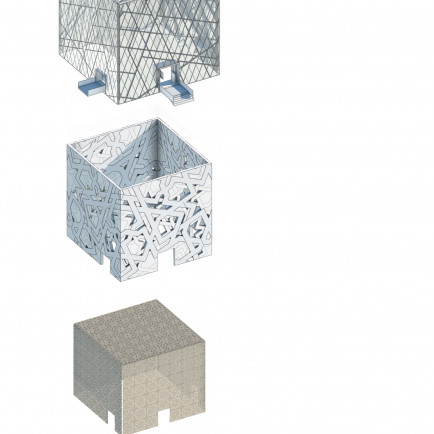KAPSARC Mosque
Description
KING ABDULLAH PETROLEUM STUDIES AND RESEARCH CENTRE, (KAPSARC), was established with the aim to design a community for a research think tank dedicated to alternative energy. As a result, all of the community buildings were designed to be sustainable, with LEED Platinum Certification awarded in June 2014. The spiritual center of the King Abdullah Petroleum Studies and Research Center (KAPSARC) community is a mosque within the linear park at the heart of the site. Highly visible throughout the community, the sanctuary is approached through outdoor courtyards aligned with Mecca and Al Kaaba, the most sacred places in Islam.
King Abdullah Petroleum Studies and Research Centre (KAPSARC) mosque in Riyadh expresses originality of time and place. The design is superbly integrated with the surroundings and the mosque swims in a sea of lights in such an inspiring way. (KAPSARC) mosque in the compound exceeds its architectural importance, as it serves a rather more vital social role for the compound employees and their families.
The Mosque is located within green areas that include series of outdoor spaces, providing an open unlimited broad vision that enables the viewer to grasp the mosque within its surroundings. The mosque, which rises about three feet above the surrounding reflecting pool and open spaces, looks as if it is raised above the water at night. The form of the mosque looks different between day and night. Its windows stylish frames surrounded by glass reflect shadows during the day, which creates a dynamic experience that vary depending on the climate and season. At night, the glass box glows with light like a lantern, with beams of light running through punctuated points at the top.
Located next to the mosque is its free standing minaret tower. The 115-foot-tall minaret is designed to complement the mosque in its similar architectural style, and its patterns of stone cladding and windows.
The main prayer hall accommodates 200 men, while a mezzanine level accommodates 100 women. The prayer hall is set within a reflecting pool and reached from elevated glass bridges leading to its entrances. This procession represents the transition of leaving the profane world to enter the sacred realm. The reflecting pool glows at night, giving the illusion that the entire building is floating over water. To either side of the prayer hall, curving walls screen supporting functions, including ablution spaces and imam’s office. The main prayer hall is designed as a 75-foot-square cube sheathed in a dynamic, layered skin. The outermost layer of glass is separated from an inner layer of stone-clad concrete by three feet.
Wrapping its walls and ceiling is a modern interpretation of an Arabic screen wall (Mashrabiya) that glows with natural light from windows and skylights to brighten the modern space. Overlapping shapes enliven the walls, while the ceiling presents a more traditional design.
The interior design allows intelligent interaction between shade and shadows, through an ingenious transformation of the traditional wall which historically exhibited the Mashrabiyyah. As such, architectural surfaces become all one modern Mashrabiyyah that works as a light filter, providing internal spaces with natural light via windows and geometric patterns that cover walls and the roof.
The exteriors of both structures are designed to represent an abstracted version of a traditional Arabic pattern and create an ever-changing experience of light and shadow. During the day, the play of shadows from the complex mullion patterns on the glass travel over the inner stone façade. Similar contrasts of light and shade animate the mosque interior over the course of a day. At night, the glass box becomes a lantern in the landscape, punctuated with points of light. Custom, square pendants arranged in a grid pattern and suspended by cables illuminate the interior.
Sustainable design started with the Master Plan. 100% of wastewater is recycled at a Sewage Treatment Plant (STP) and it is reclaimed to irrigate the public realm. The campus landscape was designed not to exceed the water budget of available Treated Sewage Effluent, with landscape materials being desert appropriate and drought tolerant. The campus’s electricity is provided by a solar PV farm at the west end of the site. Conservative expectations for the on-site solar thermal and PV systems are 20% of the annual campus energy.
The mosque, in addition to benefiting from all of the overall master plan strategies, contains a series of moves to integrate sustainable design into the building. Two of these strategies are integral into the building’s form. First, the building was designed with a 5-sided mass wall of cast-in-place concrete that is 500mm thick. The mass walls provide energy efficiency through mass rather than insulation value. The mass allows them to store energy during the day and release it through the night. In the right climate, such as Saudi Arabia, they can be a better choice than walls that are lightly framed and heavily insulated. These walls have minimal openings; they are punctuated with small openings to bring patterns of natural light into the mosque but allow little heat gain. Second, the building was designed with an interstitial space between the mass wall and the curtain wall. This space is used to reject heat from the mechanical units, located in the basement. The units exhaust air into the bottom of this space, which is vented at the back of the upper parapet, thereby creating a ventilated double skin for the project.
Details
Location
King Khalid International Airport, Riyadh 13416, Saudi Arabia
Worshippers
300
Owners
KAPSARC
Architect Name
HOK
Year of Build
2014
Drawings
Map
Description
KING ABDULLAH PETROLEUM STUDIES AND RESEARCH CENTRE, (KAPSARC), was established with the aim to design a community for a research think tank dedicated to alternative energy. As a result, all of the community buildings were designed to be sustainable, with LEED Platinum Certification awarded in June 2014. The spiritual center of the King Abdullah Petroleum Studies and Research Center (KAPSARC) community is a mosque within the linear park at the heart of the site. Highly visible throughout the community, the sanctuary is approached through outdoor courtyards aligned with Mecca and Al Kaaba, the most sacred places in Islam.
King Abdullah Petroleum Studies and Research Centre (KAPSARC) mosque in Riyadh expresses originality of time and place. The design is superbly integrated with the surroundings and the mosque swims in a sea of lights in such an inspiring way. (KAPSARC) mosque in the compound exceeds its architectural importance, as it serves a rather more vital social role for the compound employees and their families.
The Mosque is located within green areas that include series of outdoor spaces, providing an open unlimited broad vision that enables the viewer to grasp the mosque within its surroundings. The mosque, which rises about three feet above the surrounding reflecting pool and open spaces, looks as if it is raised above the water at night. The form of the mosque looks different between day and night. Its windows stylish frames surrounded by glass reflect shadows during the day, which creates a dynamic experience that vary depending on the climate and season. At night, the glass box glows with light like a lantern, with beams of light running through punctuated points at the top.
Located next to the mosque is its free standing minaret tower. The 115-foot-tall minaret is designed to complement the mosque in its similar architectural style, and its patterns of stone cladding and windows.
The main prayer hall accommodates 200 men, while a mezzanine level accommodates 100 women. The prayer hall is set within a reflecting pool and reached from elevated glass bridges leading to its entrances. This procession represents the transition of leaving the profane world to enter the sacred realm. The reflecting pool glows at night, giving the illusion that the entire building is floating over water. To either side of the prayer hall, curving walls screen supporting functions, including ablution spaces and imam’s office. The main prayer hall is designed as a 75-foot-square cube sheathed in a dynamic, layered skin. The outermost layer of glass is separated from an inner layer of stone-clad concrete by three feet.
Wrapping its walls and ceiling is a modern interpretation of an Arabic screen wall (Mashrabiya) that glows with natural light from windows and skylights to brighten the modern space. Overlapping shapes enliven the walls, while the ceiling presents a more traditional design.
The interior design allows intelligent interaction between shade and shadows, through an ingenious transformation of the traditional wall which historically exhibited the Mashrabiyyah. As such, architectural surfaces become all one modern Mashrabiyyah that works as a light filter, providing internal spaces with natural light via windows and geometric patterns that cover walls and the roof.
The exteriors of both structures are designed to represent an abstracted version of a traditional Arabic pattern and create an ever-changing experience of light and shadow. During the day, the play of shadows from the complex mullion patterns on the glass travel over the inner stone façade. Similar contrasts of light and shade animate the mosque interior over the course of a day. At night, the glass box becomes a lantern in the landscape, punctuated with points of light. Custom, square pendants arranged in a grid pattern and suspended by cables illuminate the interior.
Sustainable design started with the Master Plan. 100% of wastewater is recycled at a Sewage Treatment Plant (STP) and it is reclaimed to irrigate the public realm. The campus landscape was designed not to exceed the water budget of available Treated Sewage Effluent, with landscape materials being desert appropriate and drought tolerant. The campus’s electricity is provided by a solar PV farm at the west end of the site. Conservative expectations for the on-site solar thermal and PV systems are 20% of the annual campus energy.
The mosque, in addition to benefiting from all of the overall master plan strategies, contains a series of moves to integrate sustainable design into the building. Two of these strategies are integral into the building’s form. First, the building was designed with a 5-sided mass wall of cast-in-place concrete that is 500mm thick. The mass walls provide energy efficiency through mass rather than insulation value. The mass allows them to store energy during the day and release it through the night. In the right climate, such as Saudi Arabia, they can be a better choice than walls that are lightly framed and heavily insulated. These walls have minimal openings; they are punctuated with small openings to bring patterns of natural light into the mosque but allow little heat gain. Second, the building was designed with an interstitial space between the mass wall and the curtain wall. This space is used to reject heat from the mechanical units, located in the basement. The units exhaust air into the bottom of this space, which is vented at the back of the upper parapet, thereby creating a ventilated double skin for the project.


